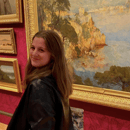For a small liberal arts campus, Connecticut College sure has a lot of art installations… and some are better than others. Here are our (completely subjective) thoughts on whether the pieces our students may spot while walking to class are “good art,” or are simply “bad:”
Lara Beckius ’24
This topic is tricky for me since there is, simply, so much art displayed on this campus. My favorite installation, however, has to be “The Cube,” formally titled Memorial Cube. This sculpture, created by artist Tony Rosenthal (1914-2009), is a half-scale replica of his famous Alamo sculpture, located in Astor Place in New York City, and was donated to the college in the memory of Dena Laib Ulin ’52. Not only is it a striking work, it also spins on its axis! Imagine my surprise when I first brushed by it—from afar, it looks like it shouldn’t be able to move at all. Now, every time I pass, I can’t help but give it a little push. In terms of art that I don’t fancy as much, I have to say I’m not a big fan of all the promotional decals that line some of the walls around campus, especially in the Crozier-Williams student center. The one on the second floor, with the camel surrounded by a huge orange squiggle, is frankly hideous. Orange isn’t even one of our campus colors! Additionally, the portraits of former Conn Coll presidents, which line the walls of the Ernst Common Room in Blaustein Humanities Center, are pretty unsettling.
Catherine Gwinnett ‘24
I am a Classics Major, which means my department is located in Blaustein Humanities Center. When I was a sophomore, having just declared my major, I decided to sign up for office hours with my advisor to set the game plan for my remaining time in school. His office was located on the third floor of Blaustein… uncharted territory for me at the time. I wanted to arrive there early, making time for mix-ups lest I got lost along the way. Fortunately, there were no hiccups and I made my way up the three flights of stairs to his office. As I climbed the final few steps, I lifted my head to see what has since become my favorite artwork on campus: the massive plaster Bust of Dante Alighieri. As I waited for my meeting to start, I waited with Dante in a perpetual staring contest. I had so many questions about this giant statue that I spent my meeting asking questions about him. Dante was a gift to Conn in 1960, and was previously located in Fanning Hall. During his time in Fanning, students apparently used to touch him for good luck. Is this good or bad art? I don’t care to speculate. In his present location, Dante oversees the students working in a Blaustein common area, looking over their shoulders with his imposing glare. For this reason, many students have told me the bust is “bad art,” since he is apparently terrifying in his monumentality and harsh expression. But on the contrary, I like to do my homework on the couch directly next to him. I can always feel his stare on my computer, keeping me focused and productive.
Madeline Motes ‘27
I never really noticed it until the middle of last semester, but I think the carvings of the central campus dorms (Branford, Plant, & Blackstone) are examples of “good art” that no one ever really pays attention to. But, look closely at the front of the buildings, and you will notice the name of the house, in addition to the year erected, on either side of the doors. These three dorms were the three original dorms on campus when Conn was founded back in 1911, with Blackstone being the oldest and built in 1914. So next time you are walking past, make sure to check them out! You might learn a little history too! Personally, the Gothic or Old English font in which the house names are carved evokes feelings of another era, perhaps England in the 1800s. I visited London last year and was able to see the similarities in the style of naming on many old buildings, which was very interesting!




